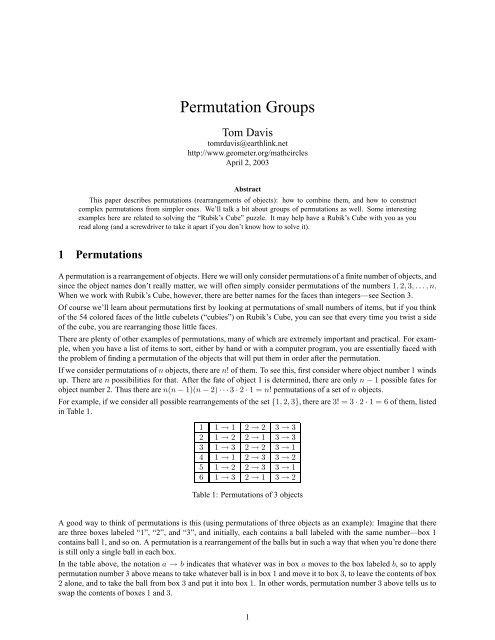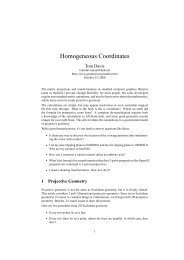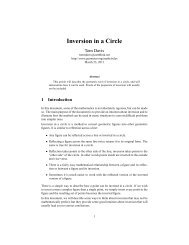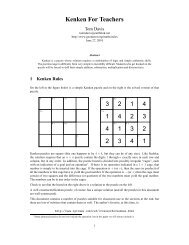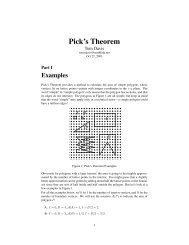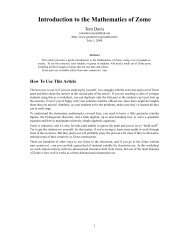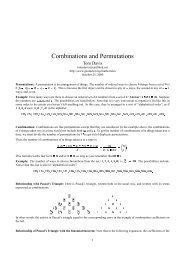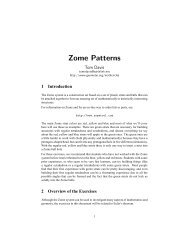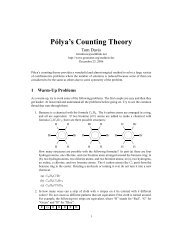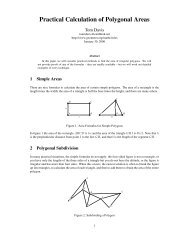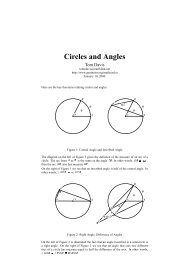Permutation Groups - Home Page -- Tom Davis
Permutation Groups - Home Page -- Tom Davis
Permutation Groups - Home Page -- Tom Davis
Create successful ePaper yourself
Turn your PDF publications into a flip-book with our unique Google optimized e-Paper software.
<strong>Permutation</strong> <strong>Groups</strong><br />
<strong>Tom</strong> <strong>Davis</strong><br />
tomrdavis@earthlink.net<br />
http://www.geometer.org/mathcircles<br />
April 2, 2003<br />
Abstract<br />
This paper describes permutations (rearrangements of objects): how to combine them, and how to construct<br />
complex permutations from simpler ones. We’ll talk a bit about groups of permutations as well. Some interesting<br />
examples here are related to solving the “Rubik’s Cube” puzzle. It may help have a Rubik’s Cube with you as you<br />
read along (and a screwdriver to take it apart if you don’t know how to solve it).<br />
1 <strong>Permutation</strong>s<br />
A permutation is a rearrangement of objects. Here we will only consider permutations of a finite number of objects, and<br />
since the object names don’t really matter, we will often simply consider permutations of the numbers 1, 2, 3, . . . , n.<br />
When we work with Rubik’s Cube, however, there are better names for the faces than integers—see Section 3.<br />
Of course we’ll learn about permutations first by looking at permutations of small numbers of items, but if you think<br />
of the 54 colored faces of the little cubelets (“cubies”) on Rubik’s Cube, you can see that every time you twist a side<br />
of the cube, you are rearranging those little faces.<br />
There are plenty of other examples of permutations, many of which are extremely important and practical. For example,<br />
when you have a list of items to sort, either by hand or with a computer program, you are essentially faced with<br />
the problem of finding a permutation of the objects that will put them in order after the permutation.<br />
If we consider permutations of n objects, there are n! of them. To see this, first consider where object number 1 winds<br />
up. There are n possibilities for that. After the fate of object 1 is determined, there are only n − 1 possible fates for<br />
object number 2. Thus there are n(n − 1)(n − 2) · · · 3 · 2 · 1 = n! permutations of a set of n objects.<br />
For example, if we consider all possible rearrangements of the set {1, 2, 3}, there are 3! = 3 · 2 · 1 = 6 of them, listed<br />
in Table 1.<br />
1 1 → 1 2 → 2 3 → 3<br />
2 1 → 2 2 → 1 3 → 3<br />
3 1 → 3 2 → 2 3 → 1<br />
4 1 → 1 2 → 3 3 → 2<br />
5 1 → 2 2 → 3 3 → 1<br />
6 1 → 3 2 → 1 3 → 2<br />
Table 1: <strong>Permutation</strong>s of 3 objects<br />
A good way to think of permutations is this (using permutations of three objects as an example): Imagine that there<br />
are three boxes labeled “1”, “2”, and “3”, and initially, each contains a ball labeled with the same number—box 1<br />
contains ball 1, and so on. A permutation is a rearrangement of the balls but in such a way that when you’re done there<br />
is still only a single ball in each box.<br />
In the table above, the notation a → b indicates that whatever was in box a moves to the box labeled b, so to apply<br />
permutation number 3 above means to take whatever ball is in box 1 and move it to box 3, to leave the contents of box<br />
2 alone, and to take the ball from box 3 and put it into box 1. In other words, permutation number 3 above tells us to<br />
swap the contents of boxes 1 and 3.<br />
1
The notation above is pretty clumsy. Here are a couple of other possibilities:<br />
1.1 Two Row Notation<br />
Write the permutation like this:<br />
( 1 2 3 4<br />
4 2 1 3<br />
where the example above indicates that the contents of box 1 moves to box 4, box 2 is unchanged, the ball in box 3<br />
moves to box 1, and the ball in box 4 moves to box 3.<br />
The advantage to this notation is that it is very easy to figure out where everything goes. The disadvantage is that it<br />
requires writing down each number twice. Since the top row can always be put in order, however, there is no real need<br />
to write it, so simply listing the second row is sufficient (assuming there is an obvious way to put the boxes in order).<br />
But there is another way that is often far more useful.<br />
)<br />
1.2 Cycle Notation<br />
Write the example above like this:<br />
(143)<br />
This indicates that the contents of box 1 moves to box 4, the contents of box 4 to box 3, and the contents of box 3<br />
moves back into box 1. The system is called “cycle notation” since the contents of the boxes in parentheses move in a<br />
cycle: 1 to 4, 4 to 3, and 3 back to 1.<br />
Some permutations have more than one cycle. For example, the cycle notation for the permutation corresponding to:<br />
is<br />
( 1 2 3 4<br />
3 4 1 2<br />
(13)(24).<br />
There are two “cycles”. 1 moves to 3 and 3 moves back to 1. At the same time, 2 moves to 4, and 4 back to 2. In other<br />
words, the contents of boxes 1 and 3 are cycled, and at the same time, the contents of boxes 2 and 4 are cycled.<br />
In cycle notation, there cannot be any duplicate elements in the various cycles that make up the permutation, so<br />
something like (13)(12) is not a valid form. As we will see in the next section, something like (13)(12) can be<br />
reduced to a valid form—in this particular case to (132).<br />
As a final example, consider this permutation of {1, 2, 3, 4, 5, 6, 7, 8}:<br />
(135)(2768).<br />
It moves the ball in box 1 to box 3, 3 to 5, and 5 back to 1. At the same time, it moves 2 to 7, 7 to 6, 6 to 8, and 8 back<br />
to 1. Notice that 4 is not involved, so it stays fixed. If you want to make it clear that 4 is a member of the set of items<br />
under consideration, but that in this particular permutation it is not moved, you can write:<br />
(135)(2768)(4).<br />
In fact, the special permutation that does not move anything is often written as: (1).<br />
Note also that the ordering doesn’t matter as long as each item to be permuted appears only once, and that you can list<br />
a cycle beginning with any member of it. All of the following indicate exactly the same permutation:<br />
(135)(2768) (2768)(135) (7682)(135)<br />
(351)(6827) (8276)(513) (6827)(513)<br />
)<br />
2
Since there are so many possible ways to label a particular permutation, if there is no convention about the labeling, it<br />
may be difficult to tell if two permutations are the same or different as the example above illustrates.<br />
If it is easy to assign an order to the elements being permuted as in the example above, then it is best to choose the<br />
representation of a permutation as follows, where we assume they elements are 1, 2, 3, . . . , n:<br />
1. Begin with the smallest element. If it is moved, list the permutation beginning with that smallest element as the<br />
first entry in the cycle.<br />
2. After listing the complete cycle, check to see if there are other elements moved by the permutation that do not<br />
appear in the cycle. If so, choose the smallest remaining, and repeat the process until all moved elements are<br />
listed.<br />
In the example above, this “canonical” representation would be the first one listed: (135)(2768).<br />
In the rest of this document, we’ll use the cycle notation and unless there is a good reason to do otherwise, we will list<br />
permutations using their canonical representations.<br />
2 Combining <strong>Permutation</strong>s<br />
Of course it’s nice to have a method to write down a permutation, but things begin to get interesting when we combine<br />
them. If you twist one face of Rubik’s Cube and then twist another one, each twist jumbles the faces, and the<br />
combination of two twists usually causes a jumbling that is more complicated than either of the two individual twists.<br />
Rather than begin with Rubik’s Cube, let’s begin by looking at permutations of just 3 objects. We listed them in<br />
Table 1, but there we used a very clumsy notation. Here are the six possible permutations of three items listed in the<br />
same order as in Table 1:<br />
(1), (12), (13), (23), (123), (132).<br />
What happens if we begin with ball 1 in box 1, ball 2 in box 2, and ball 3 in box 3, and then we apply (12) followed<br />
by (13)?<br />
A good way to think about this is to follow the contents of the boxes one at a time. For example, ball 1 begins in box<br />
1, but after (12) it has moved to box 2. The second permutation, (13), does not move the contents of box 2, so after<br />
both permutations have been applied, ball 1 will have moved to box 2. So the final result will look like this:<br />
(12 · · ·<br />
where we’re not sure what comes next. We don’t know if 2 will go back to one and the cycle will close, or whether it<br />
will continue to another box. So since the fate of 2 is in question, let’s see where it goes.<br />
The first permutation, (12) moves box 2 to box 1, and then (13) will move box 1 to box 3, so now we know the<br />
combination of permutations looks like this:<br />
(123 · · ·<br />
Since there are only three objects, we know that 3 will go back to 1 and close the cycle, but (especially when you’re<br />
beginning), it’s good to trace each ball, including ball 3 in this case.<br />
The first permutation, (12), does not move the contents of box 3, but the second, (13) moves it to box 1, so the<br />
combination of (12) followed by (13) is equivalent to the single permutation (123).<br />
Combining permutations as above is written just like a multiplication in algebra, and we can write our result as<br />
follows 1 :<br />
(12)(13) = (123).<br />
1 In other places, sometimes this “multiplication” of permutations is written in the opposite order: (13)(12) = (123). There are good reasons<br />
to choose either ordering, but here we’ll write them in the order they occur from left to right, so (12)(13) means that first (12) is applied, followed<br />
by (13).<br />
3
Beware, however. This is not the same as multiplication that you’re used to for real numbers. By doing the same<br />
analysis as above, convince yourself that:<br />
(13)(12) = (132) ≠ (123) = (12)(13).<br />
In other words, the order of multiplication makes a difference. If P 1 and P 2 are two different permutations, it may not<br />
be true that P 1 P 2 = P 2 P 1 . Multiplication of permutations is not commutative.<br />
Test your understanding of multiplication of permutations by verifying all of the entries in the “multiplication table”<br />
for the permutations of three objects in Table 2.<br />
(1) (12) (13) (23) (123) (132)<br />
(1) (1) (12) (13) (23) (123) (132)<br />
(12) (12) (1) (132) (123) (23) (13)<br />
(13) (13) (123) (1) (132) (12) (23)<br />
(23) (23) (132) (123) (1) (13) (12)<br />
(123) (123) (13) (23) (12) (132) (1)<br />
(132) (132) (23) (12) (13) (1) (123)<br />
Table 2: Multiplication table of permutations<br />
Remember that the order of multiplication is important. In Table 2, if you are trying to look up the product of (12)(13),<br />
find the column labeled (12) and the row labeled (13). If you use the row labeled (12) and the column labeled (13)<br />
you will be looking up the product (13)(12) which may be different.<br />
As a final check on your understanding of multiplication of permutations, verify the following multiplications of<br />
permutations:<br />
(1342)(3645)(1623) = (126435)<br />
(12)(23)(34)(45) = (15432)<br />
(135)(32)(54321)(413)(13) = (1)<br />
Here are some general properties of multiplication of permutations. They hold for the sets of permutations of any number<br />
of elements, but you should check to see that they do hold in the particular case of the three-element permutations<br />
in Table 2.<br />
• Closure: If P and Q are two permutations, then the products P Q and QP both make sense in that the result is<br />
also a permutation. This is obviously true since a rearrangement of a rearrangement is itself a rearrangement.<br />
• Identity: The permutation (1) that leaves everything fixed is an identity under multiplication. If P is any permutation,<br />
then P (1) = (1)P = P . In other words, the permutation (1) behaves for permutation multiplication<br />
just like the number 1 behaves for multiplication of real numbers. Sometimes the identity is written as e. It is<br />
not hard to prove that the identity is unique.<br />
• Inverses: Every permutation has an inverse that “undoes” the operation. In other words, if you apply a permutation<br />
to a set and then apply its inverse, the result is that the final order is unchanged from the original. If P is<br />
a permutation and P −1 is its inverse, we can write P P −1 = P −1 P = (1) = e.<br />
If you have a permutation written in cycle notation and you want to find its inverse, simply reverse all the cycles.<br />
For example, [(134)(256)] −1 = (652)(431). To see why this works, multiply: (134)(256)(652)(431). The<br />
result will be (1) 2 .<br />
2 Notice that we have reversed not only the contents of each cycle, but also the order of the cycles. For cycles in the canonical form, reversing<br />
the order of cycles is not important, but if the permutation is not in canonical form, reversing both orders will produce the inverse, no matter what.<br />
4
• Associativity: If P , Q, and R are any three permutations, then P [QR] = [P Q]R. In other words, if you have<br />
to multiply 3 or more permutations together, it doesn’t matter how you group them to do the multiplications.<br />
We use braces “[“ and “]” to indicate the grouping since we’ve used parentheses to indicate the cycles of the<br />
permutations.<br />
For example, let’s work out (1345)(243)(163) two different ways. First we’ll multiply (1345) by (243) and<br />
then take that result and multiply it by (163). Then we’ll do the multiplication beginning with the last two<br />
permutations (check these yourself):<br />
[(1345)(243)](163) = (1245)(163) = (124563)<br />
(1345)[(243)(163)] = (1345)(16324) = (124563)<br />
• Not (necessarily) Commutativity: This is really just a reminder that the commutative law does not hold in<br />
general. If you swap the order of a product, the result may change, so P Q and QP are not necessarily the same.<br />
There are some cases, however, where things do commute. For example, if your permutations are two cycles that<br />
share no elements in common, the order in which they occur does not matter. So (123)(45) = (45)(123). This<br />
is obviously true since each cycle rearranges a different subset of elements, so their operations are completely<br />
independent and can be reversed in order with no effect on the final outcome.<br />
2.1 Powers of Cycles<br />
Because the associative law holds, it makes sense to write something like P n where P is a permutation and n is a<br />
positive integer. P 4 = P P P P , and because the operation of permutation multiplication is associative, you get the<br />
same answer no matter how you choose to multiply them together.<br />
For example, let’s compute P 3 , where P = (134)(25).<br />
P 3 = P P P = (134)(25)(134)(25)(134)(25) = (25).<br />
In fact, it’s easy to see how powers work on cycles. Let’s look at P = (123456), for example. Here are the various<br />
powers of P :<br />
P 1 = (123456) P 2 = (135)(246) P 3 = (14)(25)(36)<br />
P 4 = (153)(264) P 5 = (165432) P 6 = (1)<br />
When raising a cycle to a power k, each elements “steps forward” by k steps, cycling back to the beginning, if<br />
necessary. It’s just like modular (clock) arithmetic. Clearly if the cycle P is n items long, then P n = (1) = e.<br />
It’s a great exercise to calculate P k for all powers of k, where P is a cycle whose length is a prime number. Try it with<br />
P = (1234567) and calculate P 1 , P 2 , P 3 , P 4 , P 5 , P 6 , and P 7 .<br />
If a permutation is written in proper cycle form where there is possibly more than one cycle, but there are no items<br />
that appear in more than one cycle, then taking powers of such a permutation is easy—just raise the individual cycles<br />
to the power and combine the results. This is because individual cycles that do not share items do commute, so, for<br />
example,<br />
[(123)(45)] 3 = (123)(45)(123)(45)(123)(45),<br />
but the (123) and the (45) cycles commute, so the right hand side can be rearranged to be:<br />
[(123)(45)] 3 = (123)(123)(123)(45)(45)(45)<br />
= (123) 3 (45) 3 .<br />
Clearly, if P is a cycle of length n, then P n = e because each application of the cycle moves all the elements in the<br />
cycle one step forward. For any permutation, we say that the order of the permutation is the smallest power of that<br />
5
permutation that is the identity. Thus if P is a cycle of 17 elements, it will have order 17, since 17 applications of it<br />
will return every ball to its original box.<br />
If P is not a cycle, but is written in proper cycle form, then the order of P is the least common multiple of the<br />
cycle lengths. This is pretty obvious—consider the permutation P = (12345)(678). If we consider that P n =<br />
(12345) n (678) n , then to make P n = e, we must have that both (12345) n = e and (678) n = e. The first will be true<br />
if n is a multiple of 5; the second if n is a multiple of 3. For both to be true, n must be a multiple of both 5 and 3, and<br />
the smallest number that is both is the least common multiple of the two: 15 in this case.<br />
3 The “Befuddler” Notation<br />
From now we will use Rubik’s Cube for some of our examples of permutations. For that reason, we need a reasonable<br />
notation to describe the moves that can be made. Here we are talking only about the standard 3 × 3 × 3 cube, although<br />
much of what we do can easily be applied to other versions.<br />
The cube has six faces, each of a different color, but different cubes have different coloring patterns, so it is useful to<br />
have a notation that is independent of the particular coloring of a cube.<br />
Here is a good method to describe a general move. Imagine that you hold the cube in front of you looking directly at<br />
the center of one face, and with the top and bottom faces parallel to the ground. There are six faces—the front and<br />
back, the up and down, and the left and right. Conveniently, the first letters of these words are all different: F , B,<br />
U, D, L, R. Rearrange them as “BF UDLR”, and it reminds you of the English word, “befuddler”, which is also<br />
appropriate for describing the general difficulty of the problems presented by the cube.<br />
There are six primitive moves that can be made—any of the six faces can be turned 1/4 turn clockwise. Obviously,<br />
if you want to turn a face counter-clockwise, that’s what you would do, but to keep the description mathematically<br />
simple using the minimum number of primitive operations, remember that a single twist counter-clockwise is the same<br />
as three clockwise twists.<br />
By “clockwise” is meant that if the face in question is grasped in the right hand, it is turned in the direction pointed to<br />
by the right thumb.<br />
We will use the befuddler letters as names for these primitive moves. Thus the move “F ” means that the front<br />
face is turned 1/4 turn clockwise, et cetera. We can combine letters as well. “F UB” means first twist the front<br />
face clockwise, then twist the up face, then the back face. All twists are 1/4 turn clockwise. To turn the front face<br />
by 1/2 turn or 3/4 turn (3/4 turn clockwise = 1/4 turn counter-clockwise), use the notation F 2 or F 3 . Note that<br />
F 4 = B 4 = U 4 = D 4 = L 4 = R 4 = e, so we could write F 3 as F −1 equally well. We will tend to use the F −1 form<br />
here.<br />
As a final example, F 2 U 3 T BD means to turn the front face a half turn, then twist the up face 1/4 turn counterclockwise,<br />
followed by a 1/4 clockwise twist of the top, then back, and then down faces.<br />
If you think of the entire cube as being composed of a bunch of smaller “cubies”, the befuddler notation gives a good<br />
method to name the individual cubies. The cubies in the corners are identified by the three faces they share. The cube<br />
on the up right front can be called URF , and so on. The edge cubies are identified by the two faces it lies on, so<br />
the one on the up and front faces would be called UF . But in order to distinguish between the cubie UF and the<br />
transformation that is a rotation about the up face followed by a rotation about the front face, we will put boxes around<br />
the cubie names: URF and UF for the cubes just mentioned.<br />
With this cubie notation, we can describe (using our permutation cycle notation) certain results that transformations<br />
may achieve. For example, ( LD F D RD ) refers to an operation that cycles the left-down, front-down, and<br />
right-down cubies. The left-down cubie moves into front-down postion, et cetera.<br />
The notation still isn’t perfect. You’ll find that when you solve Rubik’s cube that sometimes a cubie will be in the<br />
right place in the cube, but rotated (if it’s a corner cubie) or flipped (if it’s an edge cubie). But we can describe it as<br />
follows. Suppose there is an operation that leaves everything fixed, but flips UB and UL in place. We can write this<br />
as: UB , UL → BU , LU .<br />
6
4 <strong>Groups</strong> and Subgroups<br />
A group is a system consisting of a set of objects and a binary operation that produces from any two objects another<br />
object that satisfies the conditions listed in Section 2 (having an identity, an inverse, and with an associative operation).<br />
The set of all possible permutations of a set of elements is a special group called the “symmetric group”. The symmetric<br />
group on n objects is the group consisting of all permutations of n elements, so it contains n! elements—in other<br />
words, the symmetric groups get big pretty fast as n gets larger. In this paper we will denote the symmetric group on<br />
n elements by S n .<br />
Most practical applications use only a subset of the possible permutations. In Rubik’s Cube, for example, although<br />
there are 54 little colored faces, it is clear that the ones in the corners will always be in some corner, the ones on the<br />
edges remain on the edges, and the ones in the centers of the faces remain centers of faces. Thus in the collection of<br />
permutations reachable from a solved cube, there are none that move, say, a corner to an edge.<br />
We will be interested in special subsets of groups that are themselves groups—in other words, a non-empty subset of<br />
the permutations so that any product of permutations in the subset is another permutation in the subset.<br />
In our earlier example of S n (the symmetric group on three elements), there are the following subgroups (including<br />
the group that contains only the identity and the entire symmetric group):<br />
{(1)}, {(1), (12)}, {(1), (13)}, {(1), (23)}, {(1), (123), (132)},<br />
{(1), (12), (13), (23), (123), (132)}.<br />
There aren’t any others. If you try to construct some, you’ll see what happens. As an example, suppose we try to make<br />
one that contains (12) and (123).<br />
It will have to contain (12) 2 = (1) and (123) 2 = (132). It will also have to contain (123)(12) = (23) and (132)(12) =<br />
(13). But now we’ve shown that it must contain all the permutations in the symmetric group, so S 3 is the group<br />
generated by (12) and (123).<br />
If you are a beginner with Rubik’s Cube and you want to practice with some operations that jumble the cube but do not<br />
jumble it into a nightmare, consider restricting yourself to a subgroup of all the allowable moves. Here are a couple of<br />
good examples:<br />
• Only allow moves that consist of 180 ◦ turns of two opposite faces at the same time. Basically, there are only 3<br />
moves: R 2 L 2 , U 2 D 2 , and F 2 B 2 . These generate some nice patterns as well. This is a very simple subgroup.<br />
• This one is more complicated, but still not too bad. It’s basically the same as the one above, except that you’re<br />
allowed to do single turns of the opposite faces, such as LR −1 , UD −1 , and F B −1 . By repeating these moves<br />
you can, of course, get to any position in the subgroup above, but there are many more possibilities.<br />
5 Even and Odd <strong>Permutation</strong>s<br />
Begin with the following exercise: verify the following products of permutations:<br />
(12) = (12)<br />
(12)(13) = (123)<br />
(12)(13)(14) = (1234)<br />
(12)(13)(14)(15) = (12345)<br />
Although the expressions on the left are not in proper cycle notation, this does show that any cycle can be expressed<br />
as a product of 2-cycles, or exchanges. This example shows that a cycle of n objects can be written as a product of<br />
(n − 1) 2-cycles.<br />
7
In fact, there are clearly an infinite number of ways to express any permutation as a product of 2-cycles:<br />
(123) = (12)(13) = (12)(13)(12)(12) = (12)(13)(12)(12)(12)(12) = · · ·<br />
But it is true that if a permutation can be written as an even number of cycles, any representation will contain an even<br />
number of cycles. In the example above, (123) was expressed as 2, 4, 6, · · · cycles. Similarly, if a permutation allows<br />
a representation as an odd number of cycles, all its 2-cycle representations will contain an odd number of 2-cycles. All<br />
permutations can be divided into these “even” and “odd” permutations.<br />
It requires proof, of course, that it is impossible to represent a permutation with both an even and an odd number of<br />
2-cycles, and that will be shown in Section 5.1.<br />
The identity is an even permutation (zero 2-cycles), and clearly if you multiply any even permutation by another even<br />
permutation, you will get an even permutation. Thus the set of all permutations that are even form a subset of the full<br />
symmetric group. This is called the “alternating group”, and the alternating group on n objects is called A n .<br />
Table 3 is the multiplication table for the alternating group A 4 . It is a great example of a group that is complicated,<br />
but not too complicated. See what subgroups of it you can find.<br />
(1) (123) (124) (134) (234) (132) (142) (143) (243) (12)(34) (13)(24) (14)(23)<br />
(1) (1) (123) (124) (134) (234) (132) (142) (143) (243) (12)(34) (13)(24) (14)(23)<br />
(123) (123) (132) (13)(24) (234) (12)(34) (1) (143) (14)(23) (124) (134) (243) (142)<br />
(124) (124) (14)(23) (142) (13)(24) (123) (134) (1) (243) (12)(34) (143) (132) (234)<br />
(134) (134) (124) (12)(34) (143) (13)(24) (14)(23) (234) (1) (132) (123) (142) (243)<br />
(234) (234) (13)(24) (134) (14)(23) (243) (142) (12)(34) (123) (1) (132) (143) (124)<br />
(132) (132) (1) (243) (12)(34) (134) (123) (14)(23) (142) (13)(24) (234) (124) (143)<br />
(142) (142) (234) (1) (132) (14)(23) (13)(24) (124) (12)(34) (143) (243) (134) (123)<br />
(143) (143) (12)(34) (123) (1) (142) (243) (13)(24) (134) (14)(23) (124) (234) (132)<br />
(243) (243) (143) (14)(23) (124) (1) (12)(34) (132) (13)(24) (234) (142) (123) (134)<br />
(12)(34) (12)(34) (243) (234) (142) (124) (143) (134) (132) (123) (1) (14)(23) (13)(24)<br />
(13)(24) (13)(24) (142) (143) (243) (132) (234) (123) (124) (134) (14)(23) (1) (12)(34)<br />
(14)(23) (14)(23) (134) (132) (123) (143) (124) (243) (234) (142) (13)(24) (12)(34) (1)<br />
Table 3: The Alternating Group A 4<br />
5.1 Parity Preservation<br />
Earlier in this section we showed that it is possible to represent any permutation as a product of 2-cycles, and we stated<br />
without proof that any such representation of a given permutation will always contain an even number of cycles or it<br />
will always contain an odd number of cycles. We will prove that fact by showing that it is possible to assign a parity<br />
(even or odd) to any permutation in a unique way and that multiplication of an even permutation by a 2-cycle produces<br />
an odd permutation and vice-versa.<br />
When written in canonical form, a permutation will have a certain number c 1 of 1-cycles, c 2 of 2-cycles, c 3 of 3-cycles<br />
and so on. We define the parity of such a permutation as:<br />
∑<br />
c n (n + 1) mod 2. (1)<br />
n<br />
This makes sense from the observation that (123 · · · n) = (12)(13) · · · (1n) so every cycle of length n can be written<br />
as a product of n − 1 different 2-cycles. What we will show is that if this permutation is multiplied by another 2-cycle<br />
that the parity of the sum in equation 1 switches.<br />
Assume that every element is listed in the canonical permutation representation including those elements that do not<br />
move which are listed as 1-cycles. If this permutation is multiplied by the 2-cycle (km) then there are two possibilities:<br />
either the two elements k and m are in the same cycle or they appear in different cycles (where the cycles in which<br />
they appear may have length 1).<br />
8
First consider the case where they lie in the same cycle. That cycle will look like this: (kk 2 k 3 · · · k i mm 2 · · · m j ).<br />
This cycle contains i + j elements and will thus add i + j + 1 to the sum in equation 1. If this cycle is multiplied on the<br />
right by (km), we obtain: (kk 2 · · · k i )(mm 2 · · · m j ). The two resulting cycles of lengths i and j will add i + 1 + j + 1<br />
to the sum, so the parity will switch.<br />
Finally, if k and m appear in different cycles: (kk 2 k 3 · · · k i )(mm 2 · · · m j ), then if this is multiplied on the right by<br />
(km) we obtain: (kk 2 · · · k i mm 2 · · · m j ). In this case, the original cycle form contributed i + 1 + j + 1 to the sum in<br />
equation 1 and after multiplication the single cycle result contributes i + j + 1, so again, the parity changes.<br />
5.2 The 4 × 4 Sliding Block Puzzle<br />
You have probably seen the sliding block puzzle with 4 × 4 spaces and 15 blocks numbered 1 through 15, and the<br />
object is to try to slide them until they are in order. If you begin will all of them in order except that 14 and 15 are<br />
reversed, there is no solution. In other words, there is no way to convert the situation shown below on the left to the<br />
“solved” condition on the right.<br />
1 2 3 4<br />
5 6 7 8<br />
9 10 11 12<br />
13 15 14<br />
1 2 3 4<br />
5 6 7 8<br />
9 10 11 12<br />
13 14 15<br />
This can be proved by showing that the sliding operation is like a permutation group, and that the swapping of two<br />
blocks amounts to an odd permutation in that group, but the operation of sliding a block is an even permutation. No<br />
matter how many even permutations you put together, it will never be odd.<br />
A B C D<br />
E F G<br />
H I J K<br />
L M N O<br />
A B C D<br />
E F G K<br />
H I J O<br />
L M N<br />
A B C D<br />
E I F G<br />
H J K O<br />
L M N<br />
The basic idea is illustrated in the diagrams above. Suppose that initially the situation is as shown in the left-most<br />
diagram where the variables A through N represent the numbers 1 through 15 in some order. For any such situation<br />
where the open square is not in the lower-right corner, we agree to convert it to that form first by moving all possible<br />
blocks to the left and then moving all possible blocks up. The result of this when applied to the left diagram is the<br />
diagram in the center. After these moves are made, the situation is a pure permutation of the numbers 1 through 15<br />
which has either even or odd parity.<br />
On the left, there are four possible moves. If E or F is moved, then the situation is unchanged after moving the blank<br />
square to the lower-right as described above. But if block I is moved up then after the movement of the blank square<br />
to the lower-right corner is shown in the diagram on the right. It is easy to check that this is obtained from the one<br />
in the middle by the permutation (F IJKG)–an even permutation. Thus in both cases, the result of a movement of a<br />
single block results in an even permutation of the blocks. Obviously a few other cases need to be considered, but the<br />
results will be similar. Hence, it is impossible to reverse just one pair of blocks such as swapping the 14 and 15 pair.<br />
9
6 Generators<br />
Suppose you pick some complete symmetry group and choose some number of permutations from it. Then you construct<br />
the smallest subgroup that contains all of them. This is the subgroup generated by the initial set of permutations<br />
you chose.<br />
Using again S 3 as our example, what is the subgroup generated by {(123)}? Well, it has to contain (123) itself,<br />
(123) 2 = (132), (123) 3 = (1) and nothing else since higher powers of (123) start repeating: (123) 4 = (123) 3 (123) =<br />
(1)(123) = (123). In general, if n >= 3, (123) n = (123) n−3 . We know that {(1), (123), (132)} is a subgroup of<br />
S 3 so it is the subgroup generated by (123).<br />
Using Rubik’s Cube as an example, if you’ve played with it, you know that there are billions (acutally, there are a lot<br />
more!) of permutations in the “Rubik’s Cube group”, but if we consider as a generator a 1/4-twist of the front (in other<br />
words, the F move), you can see that if that is the only operation you’re allowed to do, there are only four possible<br />
rearrangments of the cube you can achieve. So that particular generator will generate a subgroup of size 4.<br />
If you have a cube handy, here’s an exercise. Begin with a solved cube. You are only allowed to make two sorts<br />
of move: F 2 and R 2 , in other words, only 180 ◦ rotations about the front and right faces are allowed. These moves<br />
certainly are permutations of the cube’s faces. Show that the order of the subgroup they generate is 6. In other words,<br />
show that you can only get the cube into 6 different patterns (including the “solved” pattern) if F 2 and R 2 are the only<br />
allowed moves.<br />
If we have a finite group (and that’s the only sort we consider in this paper), every element has some finite order. The<br />
proof is easy:<br />
Let P be some permutation, and consider P 1 , P 2 , P 3 , . . .. eventually, since there are only a finite number of elements<br />
in the group, there has to be some i and j such that P i = P j . Assume j > i. Then P j−i P i = P j = P i . Thus<br />
P j−i = e, the identity.<br />
We can also see that it’s true since every permutation expressed in proper cycle form will have an order equal to the<br />
least common multiple of the lengths of its cycles as we stated previously. The advantage of the proof in the previous<br />
paragraph is that it applies to all finite groups—not just permutation groups.<br />
On the other hand, it is sometimes quite difficult to guess what the order of an element of the permutation group might<br />
be. For example, consider the following permutation of Rubik’s Cube: F R. Suppose that it is one indivisible move.<br />
it is obvious that both the F and R moves by themselves have order 4—4 such turns return the cube to the original<br />
condition. But if you consider the pair of turns to be a single move, what is the order of that? The answer turns out to<br />
be 105—not an obvious result!<br />
My initial (and very painful) solution to the cube was based on the above concept. I knew that any operation, if<br />
repeated enough times, would return an initially solved cube back to the solved condition. But by experimentation, I<br />
found that if my operation required, say, 24 repeats to get from solved to solved, very often the condition after 12 or 8<br />
moves (these are divisors of 24) would leave most of the cubies fixed.<br />
It is pretty obvious why this works. Imagine a permutation with a cycle structure like this: P = (123)(4567)(89). We<br />
know that P 12 = e, but what does P 6 or P 4 look like? Work it out: P 6 = (46)(57), P 4 = (123). Do you see what’s<br />
going on?<br />
Here is an interesting exercise. Show that if you have a subgroup of S n that contains (12) and (123 · · · n), then the<br />
subgroup is the entire group S n . In other words, any possible permutation of n objects can be expressed as some<br />
product of a 2-cycle and an n-cycle. (Hint: If P = (123 · · · n), consider the permutations P (12)P −1 , P 2 (12)P −2 ,<br />
. . . , P n (12)P −n .)<br />
7 Conjugates<br />
If P and Q are any permutations, then the permutation P QP −1 is called a conjugate of P . In group theory, a conjugate<br />
operation is very much like a change in coordinate system.<br />
10
Here’s a concrete example from Rubik’s Cube. Suppose that you know how to swap two corner pieces that are on the<br />
same edge (see Section 10.1; let’s call this operation Q), but you’re faced with a cube where the corners you would<br />
like to swap are not on the same edge. No problem—find a simple operation (call it P ) that brings the two corners of<br />
interest to be on the same edge. If you perform P , then Q, and then “undo” P (in other words, perform P −1 , the net<br />
effect will be to move the corners to the same edge, swap the corners on that edge, and then move the corners back to<br />
where they began. Doing P , then Q, then P −1 is the same as doing P QP −1 —a conjugate of Q.<br />
8 Commutators<br />
If P and Q are any permutations, then the commutator of P and Q is P QP −1 Q −1 . It’s just a conjugate with one<br />
additional operation of Q −1 tagged onto the end.<br />
Here’s an example of a commutator in action. Suppose that you want to find an operation that flips two edge cubies on<br />
the same face in place without affecting any of the other cubies. It’s not hard to find a series of moves that leaves one<br />
face completely fixed except for flipping a single cubie on it but perhaps hopelessly jumbles the rest of the cube. Call<br />
the operation that does this P . Now let Q be a single twist of that face that puts another cubie in the same slot where<br />
the flipped cubie was. What does P QP −1 Q −1 do?<br />
P flips the cubie (but trashes the rest of the cube that’s not on the face). Q moves a different cubie to that slot. P −1<br />
then undoes all of the damage caused by P on the rest of the cube, but flips the new cubie. Q −1 just rotates the face in<br />
question back to its original condition. The operation in Section 10.4 is just such a commutator.<br />
9 Representations of Arbitrary <strong>Groups</strong><br />
In Section 4 we stated that groups are usually defined without reference to permutations. The mathematical definition<br />
of a group is simply a set of elements and a binary operation on that set that has an identity, inverses of each element,<br />
and is associative. In fact, the “multiplication table” listed below represents a valid binary operation on the elements<br />
E, A, B, and C where E is the identity:<br />
E A B C<br />
E E A B C<br />
A A E C B<br />
B B C E A<br />
C C B A E<br />
It is easy to prove, however, that for any such group it is possible to define a permutation group that behaves in exactly<br />
the same way. Here is how to do it for the group above: E ↔ (e)(a)(b)(c), A ↔ (ea)(bc), B ↔ (eb)(ac) and<br />
C ↔ (ec)(ab). Do you see how this is related to the group multiplication table?<br />
Check to see that the operations work the same. For example, show that if AB = C, then the product of the permutations<br />
corresponding to A and B yield the permutation that corresponds to C, et cetera.<br />
Thus, in a sense, all groups can be considered to be permutation groups.<br />
10 Interesting Rubik <strong>Permutation</strong>s (Spoiler!)<br />
This section contains enough information for you to solve your cube without much thinking. Don’t look at it if you<br />
like to solve puzzles by yourself.<br />
Here are some operations that may prove to be useful in solving the cube puzzle. The first three move the cubies as<br />
indicated, but some of them also may flip the edges or rotate the corners. The final two operations leave all the cubies<br />
in place, but flip edge cubies or rotate corner cubies as indicated.<br />
11
There are almost certainly better methods available—these are just the ones I found myself. For the initial stages of<br />
solving a cube, they are also too powerful. If you’re just trying to get the top face correct from a completely jumbled<br />
cube, you don’t really care what you do to the other cubies, but all the examples below are very restrictive—only the<br />
indicated cubies move; the others are left fixed by the operations.<br />
Warning: If you’re starting with a pure cube, be careful to follow the instructions below exactly—one error and your<br />
cube will be trashed. Take it slowly and remember that B is “back”, not “bottom”. Also remember that to undo<br />
an operation, you can reverse the steps starting from the back. For example, to reverse F L −1 D 2 RUR −1 , perform<br />
RU −1 R −1 D 2 LF −1 . Also, be sure to keep the top cube on top and the right cube on the right as you do these<br />
operations. For example, if the top cube is white when you begin, make sure it stays white through all the operations.<br />
Another way to avoid problems when you are a beginner is always to twist the faces with your right hand. Then if it is<br />
one of F , B, L, R, U, or D, you will twist in the direction of your thumb. If the operation is among F −1 , B −1 , L −1 ,<br />
R −1 , U −1 , or D −1 , you’ll twist away from your thumb. If you’re left-handed, think different.<br />
Finally, it is much easier to study movements if you can begin with a solved cube, but it’s pretty easy to make an error<br />
and to wind up with a cube that’s totally jumbled. If you have no idea how to solve it, this situation can be pretty<br />
depressing. But there is a way to cheat— just take the cube apart, and put it back together in the solved configuration.<br />
To take the cube apart, the easiest way is to take a screwdriver and to put it between the center cubie of a face and one<br />
of the edge cubies, and then to pry out the edge cubie. Once it’s out, it is easy to remove all the rest of the cubies,<br />
leaving a central “skeleton”. From the skeleton, put the cubies back one at a time into their correct positions.<br />
10.1 Swap Two Corners<br />
This operation swaps two corners, but also jumbles some edge cubies. Use it if you’re planning to get the corners in<br />
place first, and then work on the edges. In addition to the permutation specified, it also twists LF D .<br />
( RBD LBD )( RB F D BD LD ): RD −1 R −1 D −1 B −1 DB.<br />
10.2 Cycle Three Edge Cubies<br />
( LD F D RD ): R −1 LBRL −1 D 2 R −1 LBRL −1 .<br />
( UF UB DB ): R −1 LU 2 RL −1 B 2 .<br />
10.3 Cycle Three Corner Cubies<br />
( LUF RUB LUB ): URU −1 L −1 UR −1 U −1 L.<br />
10.4 Flip UB and UL In Place<br />
UB , UL → BU , LU : R −1 LB 2 RL −1 D −1 R −1 LBRL −1 ULR −1 B −1 L −1 RDLR −1 B 2 L −1 RU −1 .<br />
10.5 Rotate URB and URF In Place<br />
URB , URF → RBU , RF U : F D 2 F −1 R −1 D 2 RUR −1 D 2 RF D 2 F −1 U −1 .<br />
12


